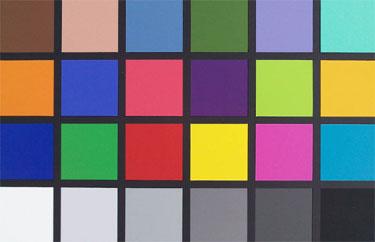Welcome to the second installment of Dr. Photo with me, Dr. Photo*. Today we?ll be talking about the Motorola Motozine ZN5, one of the new generation of high pixel count camera phones that have started popping up on US carriers. The Motozine is a little different than some of its high-resolution brethren, as its camera was developed (at least in part) through a partnership with Kodak, one of the oldest camera companies still around. Did this give Motorola a leg up in developing a camera phone that will relieve you of your need for a ?real? camera? Let's find out.
The first question I always have when picking up a new camera-type-gadget is, ?how do the pictures look?? After all, it's great if the camera looks good, and feels good, but the point of the thing is to get a great looking picture in the end.
When I started using the Motozine I immediately noticed how sharp and colorful the images looked. Compared to the Doctor's usual experience with cameraphones, this one really stood out. This is more than just on first blush, too. After getting the images onto a computer, the quality really stood out.
First of all, check out this cactus picture. I used the easily accessible macro mode (which, once again, I really appreciate having available) and the highest quality settings available to shoot this. If you look at a 100% crop of the image there are a few things worth noting. First is that the image is still remarkably sharp. Even though this is a 5 MP sensor, the physical size of the device is pretty tiny. This and the less than awesome optics that come in your standard cameraphone tend to result images not looking so good when you get close up to them - but the catcus photo from the ZN5 holds up to scrutiny. 
The other thing I immediately noticed was some that the device employs some fairly strong smoothing effects. I?ll discuss this a bit more later, but what Kodak and Motorola have done is to use a very strong noise-elimination filter on all the images that come off the camera. While you can see the effects at 100% (actual image size), not many people look at their pictures this way, so the gain of low visible noise greatly outweighs the funky smoothing effects in my opinion. In other words, for the average user, the default smoothing effects result in a noticeably better looking photo than you'd get from your average cameraphone - even your "average" 5 megapixel cameraphone.
Okay, enough nerdery for a moment. Let's get on to something a bit more practical: the flash. Now, in my previous review of the Omnia, I said I didn't particularly care for its flash. Samsung used a white LED for "flash" illumination, and it didn't do much for me. The Motozine, on the other hand has a real, honest-to-goodness Xenon flash. Check out what happens when you use it as a fill light. The first photo to the left was taken without the flash while the second phot was with the flash.

Wow! That's a real flash! Perhaps not the brightest flash in the world, but even compared to a point and shoot, that's not too shabby at all. The Doctor always recommends that you use the flash as little as possible, but when you need it, you need it. Unlike many other camera phones out there, the Motozine does a bang-up job with a flash and it even improves image noise a bit. Imagine that. Speaking of noise, let's move on a see how Motozine handles dark environments.
The dark is the hardest place to get a decent picture, especially with a small sensor camera like a point and shoot or cameraphone. Here's a picture of the Berkeley, CA city lights at night.

The noise is actually not bad considering it's basically a picture of black. The thing to notice is that the way Motorola has gotten rid of the noise is to really crank up that noise filter. This effect is especially clear in the top of the picture where there are a bunch of splotchy bits. It's great and all to use filters to get rid of noise, but in cases like this I?d almost rather have the noise - or at least the ability to turn the filter down or off. If this effect were only visible in extreme dark situations like "taking pictures of black," it would probably be a non-issue, but this isn't really the case. Even in dim light the ZN5's filter really cranks up, and pictures start to look like they were painted with oil colors. Not sexy. Especially when it's your friend's face. Again, the Motonize's Xenon flash helps with this significantly, but using the flash should be a measure of last resort.
One more little thing about Motozine's image quality: Check out the color check chart photo. The colors look nice and punchy and the contrast looks good. In comparison to the Samsung Omnia, the Motozine is a big step up in terms image quality and color rendition based on this standard alone. 
The last point I?d like to make is about the ZN5's user interface. Motozine is easy to use. There isn't much to it - a few settings, a couple of options, a button to take a picture, and that's about it. The menus are easy to navigate and the main options are selectable with the flick of a thumb. The downside of this is a lack of control. There are no ISO or aperture settings, no control over focus area or how the camera performs any number of tasks including noise reduction. Perhaps being Dr. Photo, I want too much from a cameraphone. I do believe that it is possible to build a camera into a phone that can replace, at the very least, a point and shoot camera, and the ZN5 need more in the area user image control in order to reach towards the holy grail of "true camera replacement."
The Motozine ZN5 is undeniably the best camera phone that the Doctor has used to date (ED: And the best currently available on a US Carrier, I'd say). Will it replace all point and shoot cameras? In a word? or rather two words: It depends. If you are happy taking snapshots that look great in most conditions and don't much care to fiddle with your camera's settings, this might actually replace a point and shoot for you. The image and color quality are great, the image noise (with a reasonable amount of light on the subject) is manageable and the ZN5 even has a better-than-decent flash. On the other hand, if you want a camera that will let you twiddle every setting's knob and look into the depths of its little camera soul (as the Doctor does) than this Moto is not the holy grail of cameraphones. The Doctor must say, though, that while the Motozine ZN5 will not replace his point and shoot, it is a great addition to his collection. One can't carry a camera all the time.
*To learn more about Dr. Photo and review his work, jump to his website from here.